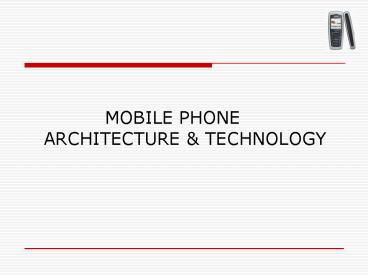MOBILE PHONE ARCHITECTURE - PowerPoint PPT Presentation
1 / 27
Title:
MOBILE PHONE ARCHITECTURE
Description:
MOBILE PHONE. ARCHITECTURE & TECHNOLOGY. HISTORY. The idea of the first cellular ... Task of this group was standardisation of digital mobile communication ... – PowerPoint PPT presentation
Number of Views:5116
Avg rating:5.0/5.0
Title: MOBILE PHONE ARCHITECTURE
1
MOBILE PHONE ARCHITECTURE
TECHNOLOGY
2
HISTORY
- The idea of the first cellular network was
brainstormed in 1947 - Disadvantages
- All the analogue system suffered from overload
- Incompatibility proprietary nature
- Roaming was not possible
3
- GSM/group special mobile started out as the name
of working group of CEPT( European conference of
Postal telecommunication) - Task of this group was standardisation of digital
mobile communication - GSM had become the name of standard itself.
- The acronym GSM had been changed from Group
Spécial Mobile to Global Systems Mobile
Telecommunications.
4
Technology
- GSM (global system mobile)
- CDMA (Code division multiple access)
5
Architecture of GSM network
6
Cellular Systems
- The geographic area is divided into cells
- Each cell has a Base Station managing the
communications - A set of cells managed by a single MSC is called
Location Area
VLR
MSC
HLR
land link
land link
VLR
MSC
Base Station
Radio link
MSC Mobile Switching Center VLR Visitor Location
Register HLR Home Location Register
7
Mobile Station (MS)
- Mobile Equipment
- International Mobile Equipment Identity (IMEI)
number - Subscriber Identity Module (SIM)
- Personal Identification Number (PIN)
- International Mobile Subscriber Identity (IMSI)
number - Enables access to subscribed services
- Smart card
8
MOBILE SWITCHING CENTER
- MSC is a sophisticated telephone exchange which
provides - circuit-switched calling
- mobility management
- GSM services to the mobile phones roaming within
the area that it serves. ie voice, data and fax
services, as well as SMS and call divert.
9
Tasks of the MSC include
- delivering calls to subscribers as they arrive
based on information from the VLR - connecting outgoing calls to other mobile
subscribers or the PSTN. - delivering SMS from subscribers to the SMSC and
vice versa - arranging handovers from BSC to BSC
- carrying out handovers from this MSC to another
- supporting supplementary services such as
conference calls or call hold. - collecting billing information.
10
BASE STATION SUB-SYSTEM
- BSS consists of two nodes
- Base Transceiver station (BTS)- BTS contains
the equipment for transmitting and receiving of
radio signals (transceivers), antennas, and
equipment for encrypting and decrypting
communications with the Base Station Controller
(BSC)
11
- Base Station Controller (BSC)
- Provides classically, the intelligence behind the
BTSs - It handles allocation of radio channels, receives
measurements from the mobile phones, controls
handovers from BTS to BTS
12
DATA BASES
- H.L.R (HOME LOCATION REGISTER)
- V.L.R (VISITOR LOCATION REGISTER)
- E.I.R (EQUIPMENT IDENTIFY REGISTER)
13
HLR
- Master subscriber database
- Used for the management of mobile subscriber
- Contains subscription levels, call restrictions,
supplementary services and most recent location
of the subscriber
14
VLR
- Temporary subscriber data base
- Contains data needed by the MSC for servicing
visiting subscribers - Contains information for all visiting mobile
subscribers
15
EIR
- Database which contains information about the
mobile equipment identity - Used for equipment security and validation of
different types of mobile equipment
16
FREQUENCY RANGE
17
ACCESS SCHEMES
18
CDMA BASICS
- CDMA (Code Division Multiple Access) splits calls
into fragments and send them over different
frequencies simultaneously - The use of multiple frequencies gives CDMA
effective protection against interference and
lost calls - CDMA supports true packet switching and does not
use time slots, therefore is more bandwidth
efficient than TDMA -- also a more direct path to
3G - Current CDMA penetration in the world market is
about 27
19
ADVANTAGES OF CDMA
- Voice quality
- Call security
- Network capacity
- Call maintenance
20
BLOCK DIAGRAM
21
MAJOR SECTIONS
- There are three major sections inside a mobile
phone - Power Section
- Radio Section
- Computer Section
22
POWER SECTION
- A Power section deals with power related tasks
such as power distribution or charging the
battery so this section is divided into two sub
sections - Power distribution
- Charging section
23
RADIO SECTION
- A radio section has basically a set of four main
functions- - Band Switching
- RF Power Amplification
- Transmitter
- Receiver
24
COMPUTER SECTION
- A computer section consists of two main functions
- CPU (central processing unit)
- Memory (RAM,FLASH,COMBO CHIP)
25
TRANSMISSION
26
PCB LAYOUT
27
NOKIA 2600































